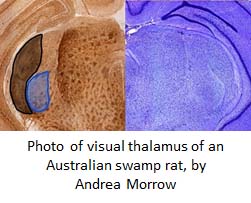Species differences in timekeeping mechanisms lead animals into worlds with very different challenges and opportunities. Photic cues available when the sun is up can carry far more information than after it has set, but only for animals that have the brain structures and mechanisms with which to extract it. One of our goals is to better understand how the brain structures related to the photic environment, and to other dimensions of an animals’ sensory world (e.g. sound), have changed along evolutionary pathways that have taken animals from one temporal niche to another. To what extent have the visual brains of diurnal animals expanded relative to those of nocturnal, crepuscular or cathemoral animals, and how is this constrained by phylogeny? Have visual structures expanded at the expense of brain regions associated with other sensory modalities, or have they actually lead to an increase in overall brain size? This project has involved collecting, processing and analyzing different regions of the sensory brains of select members of the order Rodentia. It involves traveling to sites where the animals are found, trapping them, and bringing back tissues to be processed, measured and analyzed. This work is being conducted with Dr. Barbara Lundigan and her graduate student Andrea Morrow here at MSU, and together we are collaborating with Dr. Noga Kronfeld-Schor at the University of Tel Aviv), Dr. Paul Meek (Department of Primary Industries and Invasive Animals, NSW, Australia), and others. In addition, the project has a computational component involving modeling of evolution in action that is being carried out by Dr. Arend Hintze here in the IBIO Department at MSU.


